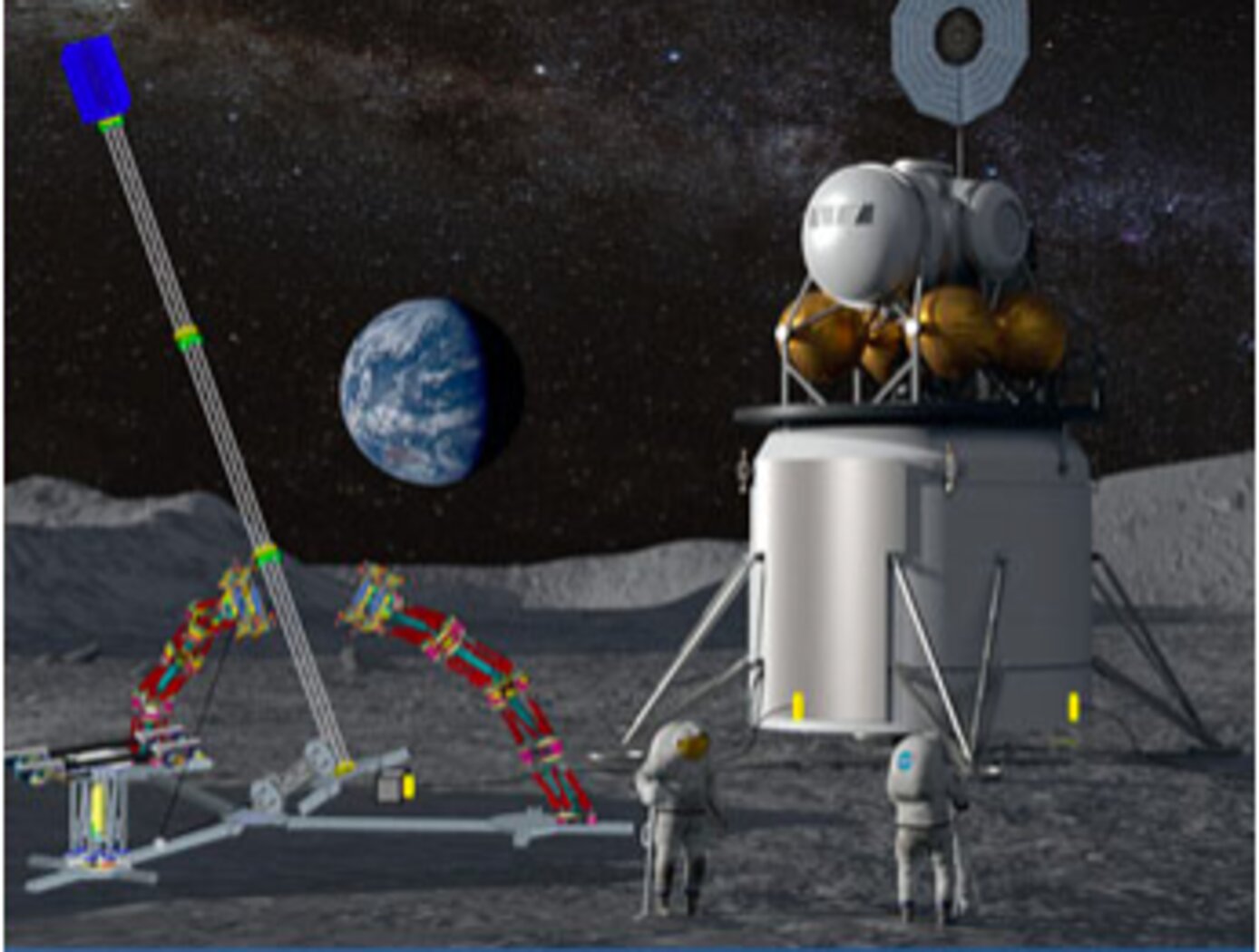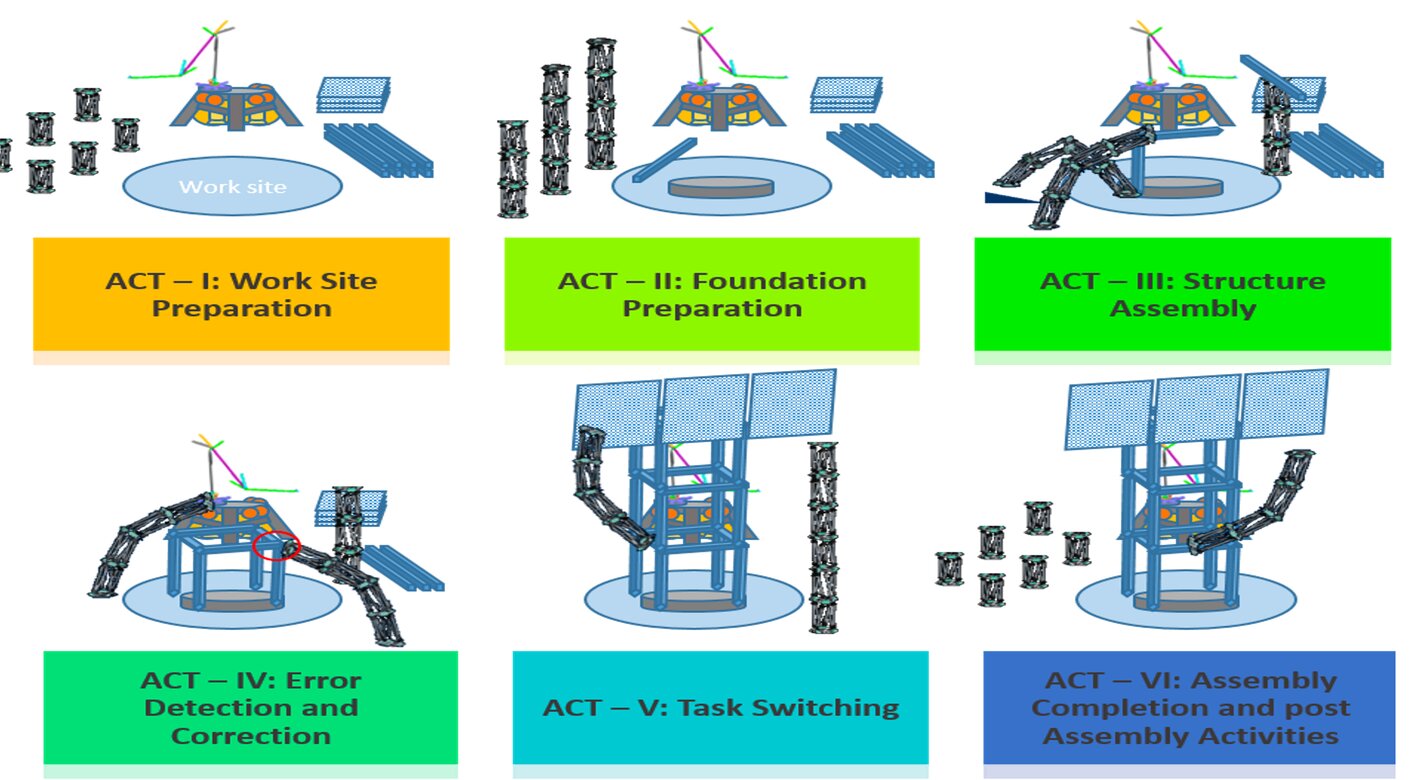Assemblers
Robotics Automation and Control
Assemblers (LAR-TOPS-345)
Teams of modular robots build structures in space, autonomously or with humans-in-the-loop
Overview
In-space and planetary surface assembly for human exploration is a challenging domain that encompasses various technological thrusts to support human missions. NASA is developing autonomous assembly agents to build structures like habitats and antennae on the Moon. These modular and reconfigurable Assembler robots will provide robotic assembly of structures, even in locations that prohibit constant human oversight and teleoperation. This system is capable of scheduling, reconfiguring, and executing structural assembly tasks; assessing construction; and correcting errors in assembly as needed. On command, the Assemblers stack themselves into robot team members for the task. For example, a few Assemblers might build a solar array as shown in the above image. The Assembler technology builds upon recent advancements in lightweight materials, state estimation, modern control theory, and machine learning. The Assembler technology builds upon recent advancements in multi-agent planning, state estimation, modern control theory, and machine learning. Compared with existing short-reach/high-accuracy and long-reach/low accuracy-assembly robots, Assemblers provides both long- and short-reach capability with accuracy and precision. NASA has developed a prototype of the technology and seeks companies that are interested in licensing the technology and commercializing it for space or other applications.
The Technology
Assemblers are a team of modular robots that work together to build things. Each Assembler is a stack of one or more Stewart platforms, or hexapods, made up of two plates connected by six linear actuators for movement, enabling a full six-degree-of-freedom (DOF) pose of the top plate relative to the bottom plate (see figure to the right). An end effector on each Assembler enables gripping, lifting, and welding/joining. The Assemblers system architecture features novel control algorithms and software, sensors, and communicator technology that coordinate operations of Assembler teams. The control system includes an important module for task management that estimates how many robots are needed, the optimal number of hexapods in each Assembler, and the estimated voltage needed. There are also modules for trajectory generation, joint control, sensor fusion, and fault detection. The novel control system directs the Assembler operations for high accuracy and precision, yet there is built-in dynamic resilience to failure. For example, if a single hexapod on an Assembler fails, the system deems it “rigid” in its last pose and redistributes the work to the other Assemblers.
The image below shows a storyboard of operations for how Assemblers might build a solar array. NASA has developed a hardware demo with communications between subsystems, backed up by detailed simulations of the kinematics and actuator dynamics.


Benefits
- Serviceability: Estimates indicate the Assemblers can enable 5- to 15-year mission life.
- Expandability: The modular architecture enables robots that are as short or as long as needed.
- Packing efficiency: Assemblers are made of advanced lightweight material.
- Modularity: Modules can be reconfigured to produce a wide range of capabilities, eliminating the need for mission-specific technologies.
Applications
- Fabrication of structures on- orbit or on the lunar surface including habitats, power trusses, science equipment, telescope supports, refueling stations, aeroshells, antennae, gravity-generator facilities, or solar arrays
- Advanced industrial manufacturing and assembly
Technology Details
Robotics Automation and Control
LAR-TOPS-345
LAR-19897-1
D. Balaban, J. Cooper and E. Komendera, "Inverse Kinematics and Sensitivity Minimization of an n-Stack Stewart Platform," 2019 IEEE/RSJ International Conference on Intelligent Robots and Systems (IROS), 2019, pp. 6794-6799, doi: 10.1109/IROS40897.2019.8968190.
John R. Cooper, James H. Neilan, Matthew Mahlin and Laura M. White, "Assemblers: A Modular, Reconfigurable Manipulator for Autonomous in-Space Assembly," 2020 AIAA Ascend Conference.Published Online:2 Nov 2020. https://doi.org/10.2514/6.2020-4132
|
Tags:
|
|
|
Related Links:
|
Similar Results

Reversible Androgynous Mechanical Fastener
The androgynous fastener is lightweight and facilitates assembly through simple actuation with large driver-positioning tolerance requirements. This fastener provides a high-strength, reversible mechanical connection and may be used in high strength-to-weight ratio structural systems, such as lattice structure systems. The androgynous fastener resists tensile and shear forces upon loading of the lattice structure system thereby ensuring that the struts of the lattice structure system govern the mechanical behavior of the system. The androgynous fastener eliminates building-block orientation requirements and allows assembly in all orthogonal build directions. This androgynous fastener may be captive in building-block structural elements thereby minimizing the logistical complexity of transporting additional fasteners. Integration of a plurality of the androgynous fasteners into a high performance, robotically managed, structural system reduces launch energy requirements, enables higher mission adaptivity and decreases system life-cycle costs. The androgynous fastener is beneficial in any application where robotic end effectors are used to join structural components (or other parts) together. It may be particularly desirable for applications requiring frequent movement of hardware to an assembly site to replace joint connections.

Robotic system for assembly and maintenance of lightweight reconfigurable structures
To enable the goal of autonomous assembly of high performing structures, a robot system must be able to travel across a lattice structure in all dimensions, transport and align a unit cell module to the correct location and fasten the module to the existing structure. In this system, a team of multiple mobile bipedal robots work together to carry, transfer, and place 3D-lattice modules (e.g., cuboctahedron voxels) to form a 3D lattice structure. The team of mobile bipedal robots autonomously provide transportation, placement, unpacking, and assembly of voxel modules into functional structures and systems. As the team of mobile bipedal robots live and locomote on the 3D-lattice structure, they monitor health and performance, enabling repair and reconfiguration when needed. The mobile bipedal robots work together in different roles, for example, one as a cargo transport robot and the other as a crane robot. The cargo transport robot and the crane robot work together to move the voxels from one location to another. Each robot includes at least one electronic control module that receives commands from another robot or a central control system. A central control system implements a plan to control the motion sequences of the robots to maximize efficiency and to optimize the work required to completely assemble a structure. The plan is pre-computed or computed during implementation by the central control system or the robots themselves, according to algorithms that utilize the regularity of the lattice structure to simplify path planning, align robotic motions with minimal feedback, and minimize the number of the degrees of freedom required for the robots to locomote across and throughout the 3D-lattice structure and perform structural assembly.

Lunar Surface Manipulation System
NASA Langley developed the LSMS because of the need for a versatile system capable of performing multiple functions on the lunar surface, such as unloading components from a lander, transporting components to an operational site and installing them, and supporting service and replacement during component life. Current devices used for in-space operations are designed to work on orbit (zero g) only and thus do not have sufficient strength to operate on planetary surfaces. Traditional cranes are specialized to the task of lifting and are not capable of manipulator-type positioning operations.
The innovations incorporated into the LSMS allow it to lower payloads to the ground over a significant portion of the workspace without use of a hoist, functioning like a robot manipulator, thus providing a rigid connection and very precise control of the payload. The LSMS uses a truss architecture with pure compression and tension members to achieve a lightweight design. The innovation of using multiple spreaders (like spokes in a wheel) allows the LSMS to maintain its high structural efficiency throughout its full range of motion. Rod portions of the tension members automatically lift off and re-engage the spreaders as the joint articulates, allowing a large range of motion while maintaining mechanical advantage. In addition, the LSMS uses a quick-change device at the tip end that enables automated acquisition of end effectors or special purpose tools to increase its versatility.

Robonaut 2: Industrial Opportunities
NASA, GM, and Oceaneering approached the development of R2 from a dual use environment for both space and terrestrial application. NASA needed an astronaut assistant able to function in space and GM was looking for a robot that could function in an industrial setting. With this in mind, R2 was made with many capabilities that offer an enormous advantage in industrial environments. For example, the robot has the ability to retool and vary its tasks. Rather than a product moving from station to station on a conveyor with dozens of specialized robots performing unique tasks, R2 can handle several assembly steps at a single station, thereby reducing manufacturing floor space requirements and the need for multiple robots for the same activities. The robot can also be used in scenarios where dangerous chemicals, biological, or even nuclear materials are part of the manufacturing process.
R2 uses stereovision to locate human teammates or tools and a navigation system. The robot was also designed with special torsional springs and position feedback to control fine motor movements in the hands and arms. R2's hands and arms sense weight and pressure and stop when they come in contact with someone or something. These force sensing capabilities make R2 safe to work side-by-side with people on an assembly line, assisting them in ergonomically challenging tasks or working independently.
This NASA Technology is available for your company to license and develop into a commercial product. NASA does not manufacture products for commercial sale.

In-Space Assembly of Structural Trusses and Shapes
The NASA innovation is based on a tessellation algorithm to break up a curved surface into identically sized equilateral surface polygons. Tessellation is a term used in mathematics that describes the process of deconstructing a surface into non-overlapping shapes with no gaps. Using this NASA innovation enables a curved-surface truss structure to be designed and built using all identical module and strut components. A key feature of this innovation is the use of a “multi-nut” connector, which enables curved surface truss structures to be assembled from identical truss modules. Uniform truss modules with customizable multi-nut connectors can be used to construct a curved-surface structure. The algorithm is a design approach for any size or surface shape.
The NASA innovation represents a major breakthrough due to:
• Versatility to a variety of planar and curved structure shapes (cylinder, sphere, etc.)
• Ability to change the shape simply by updating the “multi-nut” connectors
• Commonality of truss modules and components
• Ease of assembly
• Efficiency of construction and weight
• Robotic assembly and servicing.
In addition to a range of space related applications – mirrors, antennas, habitats, storage containers, etc. – the innovation is also directly applicable to general terrestrial assembly of systems with curvature, including for example sports stadiums, airports, aquariums, convention centers, or bridges.



